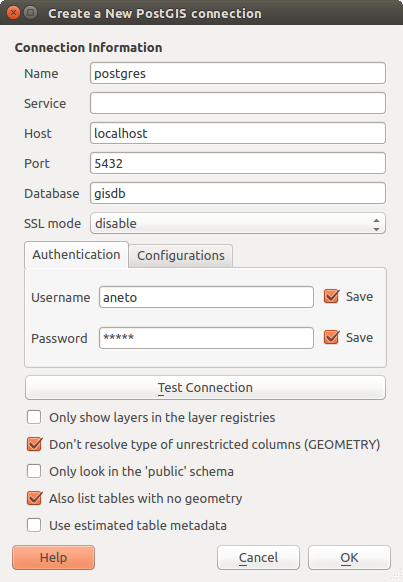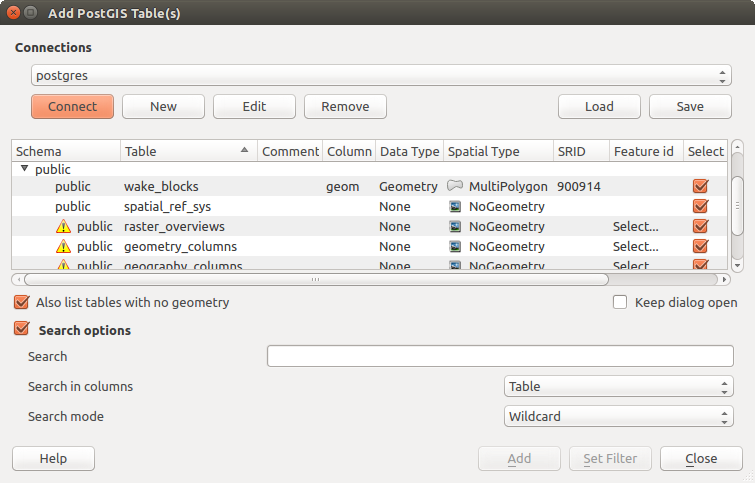` `
데이터 열기¶
오픈소스 소프트웨어 생태계의 일원으로서, QGIS는 서로 다른 라이브러리들을 기반으로 빌드되어, 자체 제공자와 결합해 다음과 같은 여러 포맷들을 읽고, 많은 경우 작성할 수도 있는 능력을 갖추고 있습니다:
- Vector data formats include ESRI formats (shapefiles, geodatabases...), MapInfo and MicroStation file formats, AutoCAD DWG/DXF, GeoPackage, GeoJSON, GRASS, GPX, KML, Comma Separated Values, and many more... Read the complete list of OGR vector supported formats;
- Raster data formats include ArcInfo Binary Grid, ArcInfo ASCII Grid, JPEG, GeoTIFF, ERDAS IMAGINE, MBTiles, R or Idrisi rasters, ASCII Gridded XYZ, GDAL Virtual, SRTM, Sentinel Data, and many more... Read the complete list of raster supported formats;
- Database formats include PostgreSQL/PostGIS, SQLite/SpatiaLite, Oracle, DB2 or MSSQL Spatial, MySQL...;
- Support of web data services (WM(T)S, WFS, WCS, CSW, ArcGIS Servers...) is also handled by QGIS providers (see OGC 데이터 클라이언트로서의 QGIS);
보존된(archived) 폴더에서 지원하는 파일을 읽어올 수 있고, 가상(virtual) 및 메모리 레이어 같은 QGIS 자체 포맷도 사용할 수 있습니다.
As of the date of this document, more than 80 vector and 140 raster formats are supported by the GDAL/OGR and QGIS native providers.
주석
목록에 있는 포맷 가운데 여러 가지 이유로 인해 QGIS에서 작동하지 않는 포맷이 있을 수도 있습니다. 예를 들어 일부 포맷은 외부 상표등록 라이브러리를 필요할 수도 있고, 사용자 OS에 GDAL/OGR을 설치했을 때 사용자가 원하는 유형을 지원하도록 빌드되지 않았을 수도 있습니다. 사용할 수 있는 포맷 목록을 얻으려면, QGIS에서 (벡터의 경우) ogrinfo --formats 명령어를 실행하거나 (래스터의 경우) settings ‣ Options ‣ GDAL 메뉴를 확인하십시오.
탐색기 패널¶
QGIS Browser is one of the main panels of QGIS that lets you quickly and easily add your data to projects. It helps you navigate in your filesystem and manage geodata, regardless the type of layer (raster, vector, table), or the datasource format (plain or compressed files, database, web services).
To add a layer into a project:
- right-click on QGIS toolbar and check
 Browser Panel
to activate it or select it from the menu View ‣ Panels
(or
Browser Panel
to activate it or select it from the menu View ‣ Panels
(or  Settings ‣ Panels);
Settings ‣ Panels); - a browser tree with your filesystem, databases and web services is displayed;
- find the layer in the list;
- right-click on its name and select Add selected layer(s). Your layer is now added to the Layers Panel and can be viewed in the map canvas.
주석
You can also add a layer or open a QGIS project directly from the Browser panel by double-clicking its name or by drag-and-drop into the map canvas.
파일을 불러들이고 나면, 맵 둘러보기 도구를 이용해서 맵을 이동 및 확대/축소할 수 있습니다. 레이어 스타일을 변경하려면, 레이어 명을 더블 클릭해서 Layer Properties 대화창을 열거나 범례에 있는 레이어 명을 오른쪽 클릭한 다음 컨텍스트 메뉴에서 Properties 을 선택하십시오. 벡터 레이어의 심볼을 설정하는 작업에 대해 더 자세히 알고 싶다면 Style Properties 을 참조하세요.
탐색기 패널 상단에 있는 아이콘의 기능은 다음과 같습니다:
 Add Selected Layers: 레이어의 컨텍스트 메뉴에서 Add selected layer(s) 를 선택해도 맵 캔버스에 데이터를 추가할 수 있습니다.
Add Selected Layers: 레이어의 컨텍스트 메뉴에서 Add selected layer(s) 를 선택해도 맵 캔버스에 데이터를 추가할 수 있습니다. Filter Browser: 특정 데이터를 검색합니다. 검색어 또는 임의 문자 기호(wildcard)를 입력하면 탐색기가 트리를 필터링해서 입력 문자열과 일치하는 데이터베이스 테이블, 파일명 또는 폴더를 가리키는 경로만 표시합니다. 일치하지 않는 다른 데이터 또는 폴더는 숨깁니다. 나란히 있는 QGIS 탐색기 패널 그림의 Browser Panel(2) 예시를 참조하십시오. 필터링 작업은 대소문자를 구분할 수도 있고 안 할 수도 있습니다. 다음 옵션으로 필터링을 설정할 수도 있습니다:
Filter Browser: 특정 데이터를 검색합니다. 검색어 또는 임의 문자 기호(wildcard)를 입력하면 탐색기가 트리를 필터링해서 입력 문자열과 일치하는 데이터베이스 테이블, 파일명 또는 폴더를 가리키는 경로만 표시합니다. 일치하지 않는 다른 데이터 또는 폴더는 숨깁니다. 나란히 있는 QGIS 탐색기 패널 그림의 Browser Panel(2) 예시를 참조하십시오. 필터링 작업은 대소문자를 구분할 수도 있고 안 할 수도 있습니다. 다음 옵션으로 필터링을 설정할 수도 있습니다:normal: 검색어를 포함하는 모든 항목을 반환합니다.
wildcard(s) 이용: 검색 문자열에서 위치를 지정하는 ? 그리고/또는 * 문자를 이용해서 검색을 세밀하게 조정합니다.
regular expression 이용
 Enable/disable properties widget: when toggled on,
a new widget is added at the bottom of the panel showing, if applicable,
metadatas of the selected item.
Enable/disable properties widget: when toggled on,
a new widget is added at the bottom of the panel showing, if applicable,
metadatas of the selected item.
탐색 트리에 있는 항목을 오른쪽 클릭하면 다음 작업을 할 수 있습니다:
파일 또는 테이블인 경우, 해당 항목의 메타데이터를 표시하거나 사용자의 프로젝트에 항목을 열 수 있습니다. 테이블의 경우 재명명하거나, 삭제하거나, 추출할 수도 있습니다.
폴더인 경우, 사용자의 즐겨찾기에 북마크해두고 탐색 트리에서 숨길 수 있습니다. Settings ‣ Options ‣ Data Sources 탭에서 이렇게 숨긴 풀더들을 관리할 수 있습니다.
데이터베이스 또는 웹 서버로의 연결을 생성할 수 있습니다.
스키마를 새로고침하거나, 재명명하거나 삭제할 수 있습니다.
단순히 드래그&드롭하는 것만으로 데이터베이스로 파일을 불러들이거나 어떤 스키마/데이터베이스에서 다른 스키마/데이터베이스로 테이블을 복사할 수도 있습니다. 드래그하는 동안 오래 스크롤을 해야 하는 일을 피하기 위해 두 번째 탐색 패널을 사용할 수 있습니다. 그냥 파일을 선택한 다음 한쪽 패널에서 다른 패널로 드래그&드롭하십시오.
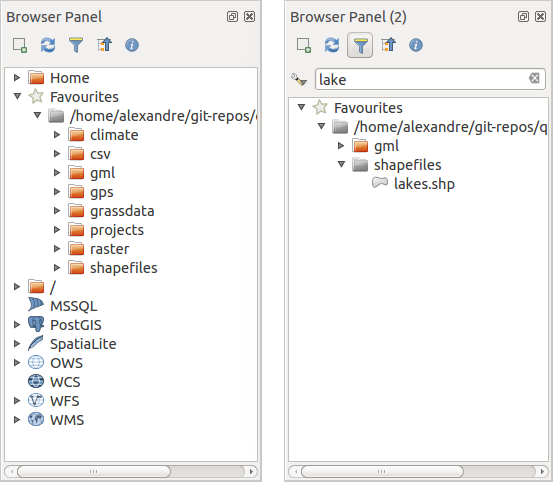
나란히 있는 QGIS 탐색기 패널
참고
사용자 OS의 파일 탐색기에서 단순히 드래그&드롭하는 것만으로 QGIS에 레이어 추가
사용자의 운영체제 파일 탐색기에서 Layers Panel 또는 맵 캔버스로 파일(들)을 드래그&드롭해서 프로젝트에 추가할 수도 있습니다.
데이터베이스 관리자¶
DB Manager 플러그인은 하나의 사용자 인터페이스에서 QGIS가 지원하는 공간 데이터베이스 유형(PostGIS, SpatiaLite, GeoPackage, Oracle Spatial, MSSQL, DB2, 가상 레이어)을 통합하고 관리하기 위한 자체 도구이자, QGIS의 주 도구 가운데 하나이기도 합니다. Plugins ‣ Manage and Install Plugins... 메뉴에서 이 플러그인을 활성화시킬 수 있습니다.
 DB Manager 플러그인은 다음 여러 기능들을 제공합니다:
DB Manager 플러그인은 다음 여러 기능들을 제공합니다:
데이터베이스에 연결해서 그 구조 및 내용을 표시합니다.
데이터베이스의 테이블을 미리보기합니다.
맵 캔버스에 레이어를 더블 클릭 또는 드래그&드롭으로 추가합니다.
QGIS 탐색기 또는 다른 데이터베이스로부터 데이터베이스에 레이어를 추가합니다.
SQL 쿼리의 산출물을 생성하고 맵 캔버스에 추가합니다.
가상 레이어 를 생성합니다.
DB 관리자 플러그인 에서 데이터베이스 관리자에 관한 더 자세한 정보를 설명하고 있습니다.
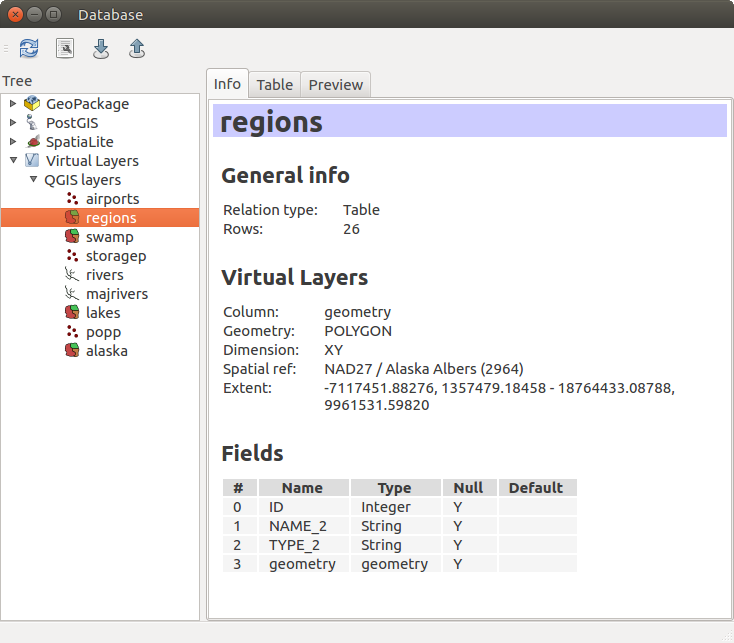
데이터베이스 관리자 대화창
제공자 기반 불러오기 도구¶
QGIS가 유형에 상관없이 레이어를 추가하기 위해 제공하는 주 도구인 탐색기 패널 및 데이터베이스 관리자 이외에도, 데이터 제공자에 특화된 도구들이 존재합니다.
주석
일부 외부 플러그인 도 QGIS에서 특정 파일 포맷을 열기 위한 도구를 제공합니다.
파일에서 레이어 불러오기¶
파일에서 레이어를 다음과 같이 불러올 수 있습니다:
for vector data (like Shapefile, Mapinfo or dxf layer), click on
 Add Vector Layer toolbar button, select the
Layer ‣ Add Layer ‣
Add Vector Layer toolbar button, select the
Layer ‣ Add Layer ‣  Add Vector
Layer menu option or press Ctrl+Shift+V.
This will bring up a new window (see figure_vector_add) from which you can
check
Add Vector
Layer menu option or press Ctrl+Shift+V.
This will bring up a new window (see figure_vector_add) from which you can
check  File and click on [Browse]. You can
also specify the encoding for the file if desired.
File and click on [Browse]. You can
also specify the encoding for the file if desired.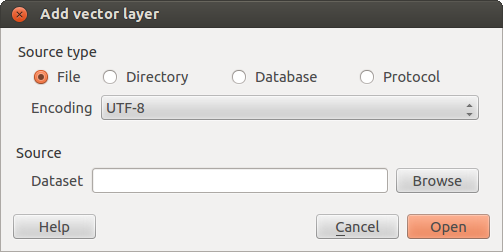
벡터 레이어 추가 대화창
래스터 레이어의 경우,
 Add Raster Layer 아이콘을 클릭하거나, Layer ‣ Add Layer ‣
Add Raster Layer 아이콘을 클릭하거나, Layer ‣ Add Layer ‣  Add Raster Layer 메뉴 옵션을 선택하거나, Ctrl+Shift+R 조합 키를 누르십시오.
Add Raster Layer 메뉴 옵션을 선택하거나, Ctrl+Shift+R 조합 키를 누르십시오.
표준 파일 열기 대화창(OGR 지원 벡터 레이어 열기 대화창 그림 참조)이 열릴 겁니다. 이 창에서 파일 시스템을 둘러보고 shapefile, GeoTIFF 또는 다른 지원 데이터소스를 불러올 수 있습니다. 선택 상자 Filter  를 통해 몇몇 지원 파일 유형을 사전 선택할 수 있습니다. 잘 검증된 포맷들만 목록에 표시됩니다. All files (*.*) 를 선택하면 다른 검증 안 된 포맷들도 불러올 수 있습니다.
를 통해 몇몇 지원 파일 유형을 사전 선택할 수 있습니다. 잘 검증된 포맷들만 목록에 표시됩니다. All files (*.*) 를 선택하면 다른 검증 안 된 포맷들도 불러올 수 있습니다.
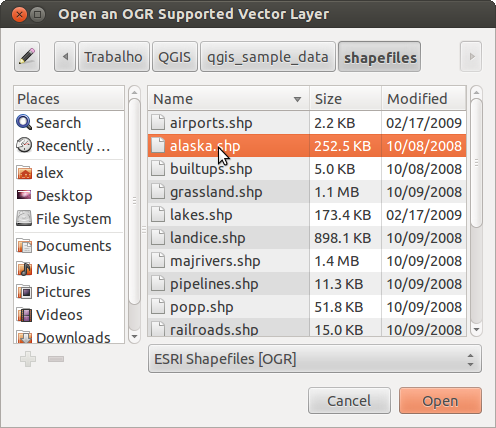
OGR 지원 벡터 레이어 열기 대화창
Selecting a file from the list and clicking [Open] loads it into QGIS. More than one layer can be loaded at the same time by holding down the Ctrl or Shift key and clicking on multiple items in the dialog. Figure_vector_loaded shows QGIS after loading the alaska.shp file.
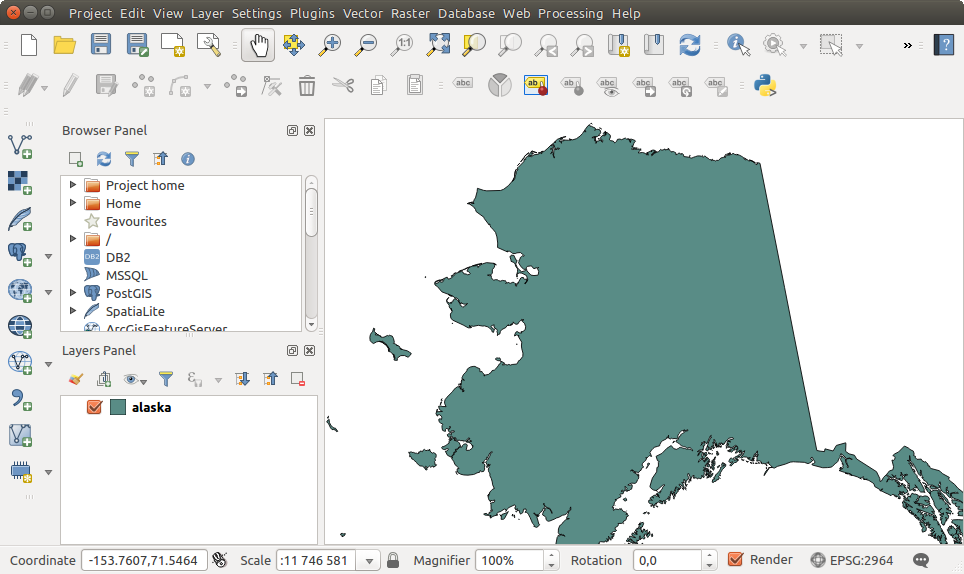
알래스카 shapefile을 불러들인 QGIS
주석
MapInfo(예를 들면 .tab) 또는 Autocad(.dxf) 같은 일부 포맷은 파일 하나 안에 서로 다른 도형 유형을 함께 담을 수 있기 때문에 QGIS에 이런 포맷을 불러올 경우, 레이어 하나 당 도형 유형 하나만 보유할 수 있도록, 사용할 도형을 선택할 수 있는 대화창이 열립니다.
Using the  Add Vector Layer tool:
Add Vector Layer tool:
You can also load specific formats like ArcInfo Binary Coverage, UK. National Transfer Format, as well as the raw TIGER format of the US Census Bureau or OpenfileGDB. To do that, you’d need to select
 Directory as Source type. In this case
a directory can be selected in the dialog after pressing [Browse].
Directory as Source type. In this case
a directory can be selected in the dialog after pressing [Browse].With the
 Database source type you can select an
existing database connection or create one to the selected database type.
Available database types are ODBC, OGDI Vectors, Esri Personal
Geodatabase, MySQL as well as PostgreSQL or MSSQL.
Database source type you can select an
existing database connection or create one to the selected database type.
Available database types are ODBC, OGDI Vectors, Esri Personal
Geodatabase, MySQL as well as PostgreSQL or MSSQL.Pressing the [New] button opens the Create a New OGR Database Connection dialog whose parameters are among the ones you can find in 저장된 연결 생성하기. Pressing [Open] you can select from the available tables for example of the PostGIS enabled database.
The last source type,
 Protocol, enables to open
data from the web using for example GeoJSON or CouchDB format. After
selecting the type you have to fill URI of the source.
Protocol, enables to open
data from the web using for example GeoJSON or CouchDB format. After
selecting the type you have to fill URI of the source.
참고
맥OS에 마운트된 외부 드라이브로부터 레이어와 프로젝트 불러오기
On macOS, portable drives that are mounted beside the primary hard drive do not show up as expected under File ‣ Open Project. We are working on a more macOS-native open/save dialog to fix this. As a workaround, you can type /Volumes in the File name box and press Enter. Then you can navigate to external drives and network mounts.
구분 텍스트 파일 가져오기¶
Delimited text file (e.g. .csv, .txt) can be loaded in QGIS
using the tools described above. However, loaded this way, it’ll show up like a
simple table data. Sometimes, delimited text files can contain geometric data
you’d want to visualize; this is what the  Add
Delimited Text Layer is designed for.
Add
Delimited Text Layer is designed for.
Click the toolbar icon  Add Delimited Text Layer in the
Manage layers toolbar to open the Create a Layer from a
Delimited Text File dialog, as shown in figure_delimited_text.
Add Delimited Text Layer in the
Manage layers toolbar to open the Create a Layer from a
Delimited Text File dialog, as shown in figure_delimited_text.
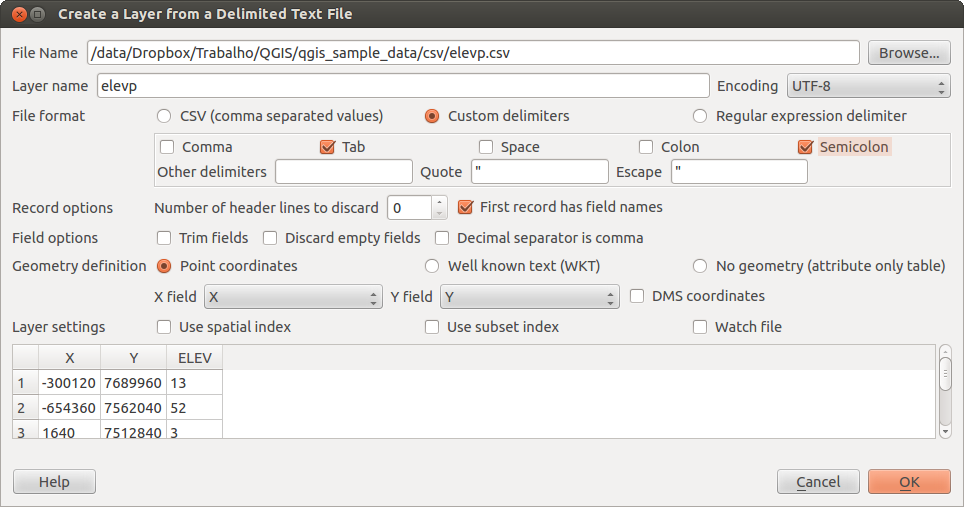
구분 텍스트 대화창
First, select the file to import (e.g., qgis_sample_data/csv/elevp.csv) by clicking on the [Browse] button. Once the file is selected, QGIS attempts to parse the file with the most recently used delimiter. To enable QGIS to properly parse the file, it is important to select the correct delimiter. You can specify a delimiter by activating:
 CSV (comma separated values);
CSV (comma separated values); Custom delimiters: comma, space, tab, semicolon 등등 사전 정의된 여러 구분자들 가운데 선택합니다.
Custom delimiters: comma, space, tab, semicolon 등등 사전 정의된 여러 구분자들 가운데 선택합니다. Regular expression delimiter: Expression 란에 구분자로 이용할 텍스트를 입력합니다. 예를 들어 구분자를 탭으로 변경하려면, (탭 문자를 나타내는 정규 표현식인) \t 를 입력하세요.
Regular expression delimiter: Expression 란에 구분자로 이용할 텍스트를 입력합니다. 예를 들어 구분자를 탭으로 변경하려면, (탭 문자를 나타내는 정규 표현식인) \t 를 입력하세요.
Once the file is parsed, set Geometry definition to
 Point coordinates and choose the X and Y
fields from the dropdown lists. If the coordinates are defined as
degrees/minutes/seconds, activate the
Point coordinates and choose the X and Y
fields from the dropdown lists. If the coordinates are defined as
degrees/minutes/seconds, activate the  DMS coordinates
checkbox.
DMS coordinates
checkbox.
Finally, enter a layer name (e.g., elevp), as shown in figure_delimited_text. To add the layer to the map, click [OK]. The delimited text file now behaves as any other map layer in QGIS.
There is also a helper option that allows you to trim leading and trailing
spaces from fields —  Trim fields. Also, it is possible
to
Trim fields. Also, it is possible
to  Discard empty fields. If necessary, you can force a
comma to be the decimal separator by activating
Discard empty fields. If necessary, you can force a
comma to be the decimal separator by activating  Decimal
separator is comma.
Decimal
separator is comma.
If spatial information is represented by WKT, activate the  Well Known Text option and select the field with the WKT definition
for point, line or polygon objects. If the file contains non-spatial data,
activate
Well Known Text option and select the field with the WKT definition
for point, line or polygon objects. If the file contains non-spatial data,
activate  No geometry (attribute only table) and it
will be loaded as an ordinal table.
No geometry (attribute only table) and it
will be loaded as an ordinal table.
여기에 더해, 다음 옵션을 활성화시킬 수 있습니다:
DXF 또는 DWG 파일 가져오기¶
DXF and DWG files can be added to QGIS by simple drag-and-drop from the common Browser Panel. You’ll be prompted to select the sublayers you’d like to add to the project. Layers are added with random style properties.
주석
포인트, 라인 그리고/또는 폴리곤 같은 도형 유형을 담고 있는 DXF 파일의 경우, <filename.dxf> entities <geometry type> 을 따와서 레이어를 명명합니다.
To keep the dxf/dwg structure and its symbology in QGIS, you may want to use the dedicated Project ‣ DWG/DXF Import... tool. Indeed, the DWG/DXF Import dialog allows you to import into GeoPackage database any element of the drawing file.
In the dialog, you have to:
- Input a location for a GeoPackage file, that will be created to store the DWG/DXF content to;
- Specify which coordinate system the data in the DWG data is in;
- Then use the [Import] button to select the DWG/DXF file to use (one per geopackage). The GeoPackage database will be automatically populated with the drawing file content. Depending on the size of the *CAD file, this could take some time;
- The
 Expand block references will transform the existing
blocks into normal elements;
Expand block references will transform the existing
blocks into normal elements; - the
 Use curves promotes the output layers geometry type
to a curved one.
Use curves promotes the output layers geometry type
to a curved one.
After the .dwg or .dxf data is imported into the GeoPackage database the frame in the lower half of the dialog is populated with the list of layers from the imported file. There you can select which layers to add to the QGIS project:
- At the top, set a Group name to group the drawing files in the project;
- Check layers to show: Each selected layer is added to an ad hoc group which contains vector layers for the point, line, label and area features of the drawing layer. The style of each layer is setup so that it resembles the look it originally had in *CAD;
- Check whether layer should be visible at opening;
- Alternatively using the
 Merge layers option places all
layers in a single group;
Merge layers option places all
layers in a single group; - Press [OK] to open the layers in QGIS.
OpenStreetMap 벡터 가져오기¶
최근 몇 년 동안, OpenStreetMap 프로젝트가 인기를 끌고 있습니다. 많은 나라에서 디지털 도로 지도 같은 무료로 쓸 수 있는 지리 데이터가 없기 때문입니다. GPS 데이터, 항공사진 또는 현지인의 지식으로부터 편집 가능하고 무료인 세계 지도를 생성하는 것이 OSM(OpenStreetMap) 프로젝트의 목표입니다. 이 목표를 돕기 위해, QGIS는 OSM 데이터를 지원하고 있습니다.
Browser Panel 을 통해 맵 캔버스에 .osm 파일을 불러올 수 있는데, 이때 도형 유형을 바탕으로 하위 레이어를 선택할 수 있는 대화창이 열립니다. 불러온 레이어는 파일에 있는 모든 도형 유형 데이터를 담고 있으며 .osm 파일 데이터 구조를 유지할 것입니다.
To avoid working with a such complex data structure, and be able to select only features you need based on their tags, QGIS provides a core and fully integrated OpenStreetMap import tool:
- To connect to the OSM server and download data, open the menu Vector ‣ OpenStreetMap ‣ Download data.... You can skip this step if you already obtained an .osm XML file using JOSM, Overpass API or any other source;
- The menu Vector ‣ OpenStreetMap ‣ Import Topology from XML... will convert your .osm file into a SpatiaLite database and create a corresponding database connection;
- The menu Vector ‣ OpenStreetMap ‣ Export Topology to
SpatiaLite... then allows you to open the database connection, select the
type of data you want (points, lines, or polygons) and choose tags to import.
This creates a SpatiaLite geometry layer that you can add to your
project by clicking on the
 Add SpatiaLite Layer toolbar button or by selecting the
Add SpatiaLite Layer toolbar button or by selecting the
 Add SpatiaLite Layer... option
from the Layer menu (see section SpatiaLite 레이어).
Add SpatiaLite Layer... option
from the Layer menu (see section SpatiaLite 레이어).
GRASS¶
GRASS GIS 통합 에서 GRASS 벡터 데이터 작업을 설명하고 있습니다.
SpatiaLite 레이어¶
 처음으로 SpatiaLite 데이터베이스에서 데이터를 불러오는 경우, 다음 가운데 한 방법으로 시작하십시오:
처음으로 SpatiaLite 데이터베이스에서 데이터를 불러오는 경우, 다음 가운데 한 방법으로 시작하십시오:
Ctrl+Shift+L 조합 키를 누릅니다.
This will bring up a window that will allow you either to connect to a SpatiaLite database already known to QGIS, which you can choose from the drop-down menu, or to define a new connection to a new database. To define a new connection, click on [New] and use the file browser to point to your SpatiaLite database, which is a file with a .sqlite extension.
QGIS는 SpatiaLite에서 편집할 수 있는 뷰도 지원합니다.
QGIS 사용자 지정 포맷¶
QGIS는 특화된 불러오기 도구를 이용해 응용 프로그램에 불러올 수 있는 사용자 지정 포맷을 2개 제공합니다.
임시 스크래치 레이어(Temporary Scratch Layer): 함께 열린 프로젝트에 종속된 메모리 레이어 (자세한 내용은 새 임시 스크래치 레이어 생성하기 참조)
가상 레이어(Virtual Layer): 다른 레이어(들)에 대한 쿼리에서 산출된 레이어 (자세한 내용은 Creating virtual layers 참조)
웹 서비스를 연결하기¶
QGIS를 통해 서로 다른 OGC 웹 서비스 유형(WM(T)S, WFS(-T), CSW 등등)에 접근할 수 있습니다. QGIS 서버 덕분에, 이 서비스들을 웹 상에 공개할 수도 있습니다. OGC 데이터 작업 에서 이런 역량 및 방법에 대해 설명하고 있습니다.






